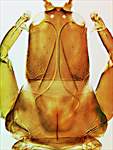
australis head & pronotum
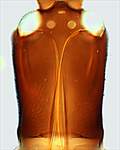
bunyai head
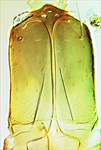
circulus head
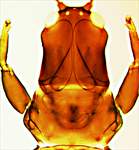
eurytis head & pronotum

federicae head
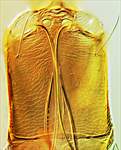
lamingtoni head
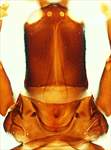
notialis head & pronotum

australis metanotum & pelta

oceanicus metanotum & pelta
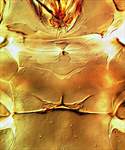
australis prosternites
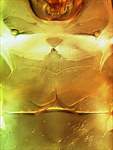
eurytis prosternites
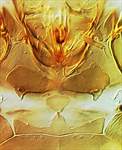
oceanicus prosternites

speciosissimus prosternites

australis male sternites VI-VIII

bunyai antenna

federicae antenna

oceanicus antenna

eurytis female

federicae female
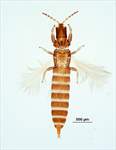
oceanicus female
Generic diagnosis
Moderately large, dark, macropterous Phlaeothripinae with stylets unusually wide. Head longer than wide, elevated in mid-line; maxillary stylets 3–6 microns wide, retracted to compound eyes, close together medially for full length of head, often with a small or large loop within the prothorax. Antennae 8-segmented but with the suture between VII–VIII variably incomplete or even absent; antennal segment III with 3 sense cones, IV with 4 sense cones. Pronotum transverse, with 5 pairs of major setae; notopleural sutures complete. Prosternal basantra absent; metathoracic sternopleural sutures present, often long. Metanotum usually with some small discal setae on anterior third, median setal pair weak. Fore tarsus with tooth in both sexes. Fore wing parallel-sided, with duplicated cilia. Pelta without campaniform sensilla; tergites II–VI with 2 pairs of wing-retaining setae, but anterior pair on each tergite often weakly developed, both pairs often weak or absent on VII; tergite IX major setae long, setae iS short; tube shorter than head, commonly yellow in part with grey terminal band; male sternite VIII with no pore plate but sternites IV–VII commonly with paired areas of specialized reticulation.
Nomenclatural data
Holothrips Karny, 1911: 502. Type species Holothrips ingens Karny, 1911, by monotypy.
There are over 140 species worldwide recognised in this genus (ThripsWiki, 2022).
Australian species
Holothrips australis (Mound, 1974: 12)
Holothrips bunyai Mound & Tree, 2014: 127
Holothrips circulus Mound & Tree, 2014: 128
Holothrips eurytis Mound & Tree, 2014: 128
Holothrips federicae Mound & Tree, 2014: 129
Holothrips frerei Mound & Tree, 2014: 130
Holothrips lamingtoni Mound & Tree, 2014: 131
Holothrips notialis Mound & Tree, 2014: 132
Holothrips oceanicus Okajima, 1987: 37
Holothrips speciossissimus (Karny, 1920: 42)
Relationship data
Relationships of this worldwide genus are far from clear, but in view of the long and relatively broad maxillary stylets it is usually associated with the Docessissophothrips group of genera, including Asemothrips.
Distribution data
Essentially a genus of tropical countries, a few species are also found in warm temperate areas (Okajima 1987).
Biological data
Fungus-feeding on dead branches, but not often found in large colonies.
References
Mound LA & Tree DJ (2014) Fungus-feeding phlaeothripine Thysanoptera in the genus Holothrips from Australia and New Caledonia, with a structurally similar new genus, Holoengythrips. Zootaxa 3860 (2): 125–148.
Okajima S (1987) Studies on the old world species of Holothrips (Thysanoptera, Phlaeothripidae). Bulletin of the British Museum (Natural History), Entomology 54: 1–74.
ThripsWiki (2022) ThripsWiki - providing information on the World's thrips. Available from: http://thrips.info/wiki/ (Accessed 15.iii.2022)